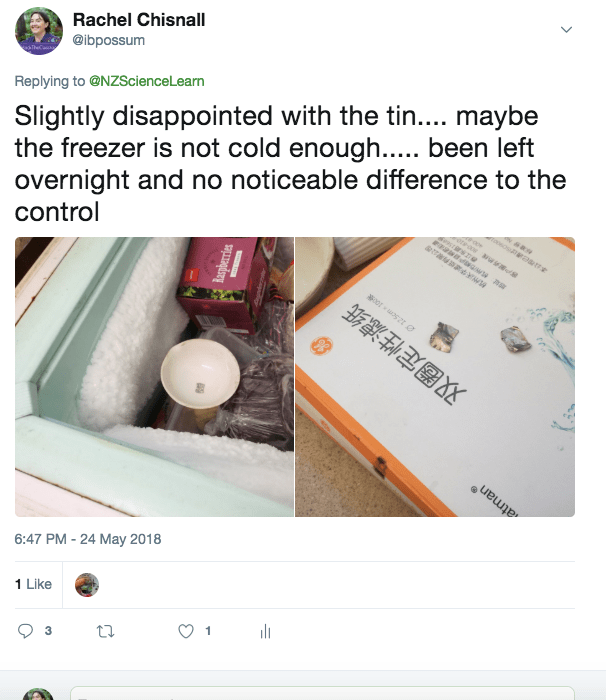I am sometimes reminded of how small things can be so important. Making connections, learning new things and questioning things said can make such a difference to learning, engagement and interest, including mine. So this a wee story about some buttons, some exploring, some learning and some fun.
Recently the Science Learning hub posted a tweet about Napolean’s armies and how their coat buttons succumbed to ‘tin pest’.
Tin below 0 °C changes to grey tin, which is soft & crumbly
The tin buttons on the tunics of Napoleon’s soldiers crumbled in the cold
Bet Napoleon wished he’s known more about ‘Metals, alloys and metal compounds’ https://t.co/KOya9Js8TN#STEMeducationNZ#Chemistry #scichatnz pic.twitter.com/oktuiqLNSh— Science Learning Hub (@NZScienceLearn) May 17, 2018
I didn’t know that Tin did this, and was immediately intrigued – as were a couple of my L3 chem students I talked to about it.
So I tweeted back, and we put some tin in the freezer

But nothing happened….

and got this reply

So…. we left it for a bit longer…..
But after a weekend at -19 C, it was still just tin
So then we melted some tin 🙂
Tin is melted and in the freezer for the long weekend #scichatnz pic.twitter.com/2mDXm5vl7O
— Rachel Chisnall (@ibpossum) May 30, 2018
But it still wasn’t enough….

In the middle of this discussion, the plot thickened with some more information about tin pest and solder…..
Oh wait, this article (which is a great summary, have a look) suggests that germanium can aid the transformation.https://t.co/9ckPtIqWxF
— Kat Day ⚗️🖋 (@chronicleflask) June 5, 2018
So of course melted some solder to make another ‘button’
And some discussions around purity of tin

Then Science learning hub popped in again with some more ideas and some more people to contribute
That said I’ve just done some googling and this is quite a contentious area – some really reputable sites support the story – other’s not so sure – https://t.co/aPByVPbikp I think you’ve discovered something we need to add a note to!
— Science Learning Hub (@NZScienceLearn) May 27, 2018
Is it a myth that the tin buttons on Napoleons soldiers uniform crumbled in the below zero temperatures? @ChemistryWorld @NatureChemistry @smithsonian @RoySocChem @alomshaha @beth_halford @carmendrahl @chronicleflask @500womensci https://t.co/SsEQpvHfoZ
— Science Learning Hub (@NZScienceLearn) June 5, 2018
I’ve updated our image abstract thanks to all your investigations and some of our own (fabulous ‘nature of science’ stuff)- https://t.co/8hkkx5NYox thanks Rachel & @chronicleflask
— Science Learning Hub (@NZScienceLearn) June 6, 2018
And the best upshot from my kids point of view was when my students went into the university as part of 3.1, they got to play with some dry ice….
@DaveDwarren@ibpossum can confirm that dry ice did not shatter the tin button 🤔pic.twitter.com/N0gGjPI0c9
— Arphonage / Caleb (@Arphonage) June 12, 2018
The current update is the tin is in a -80 C freezer somewhere – or maybe still on Dave’s desk.
So in a very busy couple of weeks, with internal assessments, report and all sorts of chaos and disappointments, this was just awesome. My students and I were ‘chatting’ with world class chemists, doing some experiments, having an explore, in no way related to credits. It was awesome – we skimmed over history, weather, complex chemical structures, alloys and physical properties related to structures, more history learning about expeditions across Antartica, pipe organs and archeological digs. My students loved it, and so did I.
And we will let you know what happens with the tin 🙂
well that’s a pretty “cool” story – pun as well, cool book – Napoleon’s Buttons, Penny Le Couteur – actually, more cool was the talk she gave – possible speaker for ChemED??
I’ve just heard of the book from twitter – and would love to have her at chem ed